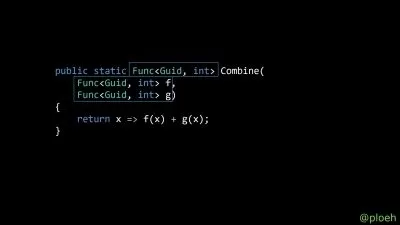Simple Object-Oriented Design, Video Edition
Focused View
4:27:10
0 View
Chapter 1. A short dive into the architecture of an information system.mp4
05:02
Chapter 1. Designing simple object-oriented systems.mp4
10:57
Chapter 1. Exercises.mp4
00:37
Chapter 1. It s all about managing complexity.mp4
03:24
Chapter 1. Simple design as a day-to-day activity.mp4
04:36
Chapter 1. Summary.mp4
01:04
Chapter 1. The example project PeopleGrow!.mp4
02:59
Chapter 2. Exercises.mp4
00:44
Chapter 2. Make code readable and documented.mp4
11:04
Chapter 2. Making code small.mp4
13:06
Chapter 2. Move new complexity away from existing classes.mp4
08:19
Chapter 2. Summary.mp4
00:47
Chapter 3. Design effective data validation mechanisms.mp4
15:47
Chapter 3. Encapsulate state checks.mp4
04:22
Chapter 3. Exercises.mp4
00:45
Chapter 3. Keeping objects consistent.mp4
11:21
Chapter 3. Model aggregates to ensure invariants in clusters of objects.mp4
08:18
Chapter 3. Provide only getters and setters that matter.mp4
06:06
Chapter 3. Summary.mp4
00:46
Chapter 4. Avoid coupling to details or things you don t need.mp4
10:28
Chapter 4. Break down classes that depend on too many other classes.mp4
04:29
Chapter 4. Exercises.mp4
00:33
Chapter 4. Inject dependencies, aka dependency injection.mp4
07:39
Chapter 4. Managing dependencies.mp4
11:54
Chapter 4. Summary.mp4
00:30
Chapter 5. Designing good abstractions.mp4
18:13
Chapter 5. Exercises.mp4
00:30
Chapter 5. Generalize important business rules.mp4
08:11
Chapter 5. Prefer simple abstractions.mp4
05:35
Chapter 5. Summary.mp4
00:42
Chapter 6. Encapsulate low-level infrastructure errors into high-level domain errors.mp4
02:52
Chapter 6. Exercises.mp4
00:31
Chapter 6. Handling external dependencies and infrastructure.mp4
17:53
Chapter 6. Only depend on things you own.mp4
08:54
Chapter 6. Summary.mp4
00:48
Chapter 6. Use the infrastructure fully.mp4
08:48
Chapter 7. Achieving modularization.mp4
10:19
Chapter 7. Design clear interfaces.mp4
13:56
Chapter 7. Exercises.mp4
00:45
Chapter 7. No intimacy between modules.mp4
15:00
Chapter 7. Summary.mp4
00:45
Chapter 8. Accept that your code won t ever be perfect.mp4
00:33
Chapter 8. Being pragmatic.mp4
01:38
Chapter 8. Consider redesigns.mp4
01:01
Chapter 8. Exercises.mp4
00:46
Chapter 8. Refactor aggressively but in small steps.mp4
01:00
Chapter 8. References.mp4
01:20
Chapter 8. Summary.mp4
00:55
Chapter 8. You owe this to junior developers.mp4
00:38
More details
User Reviews
Rating
average 0
Focused display
Category

Udemy
View courses UdemyStudents take courses primarily to improve job-related skills.Some courses generate credit toward technical certification. Udemy has made a special effort to attract corporate trainers seeking to create coursework for employees of their company.
- language english
- Training sessions 49
- duration 4:27:10
- Release Date 2024/11/03









